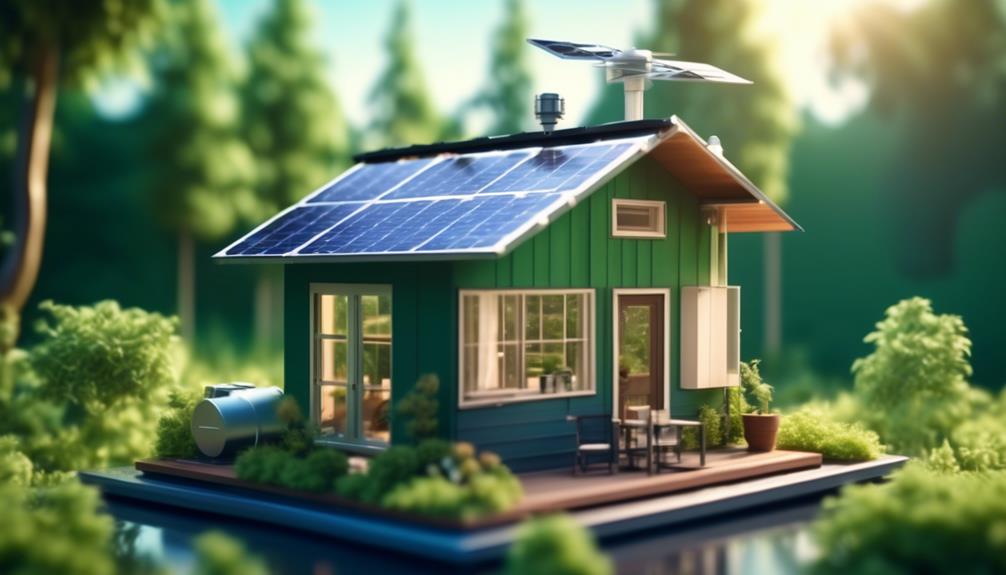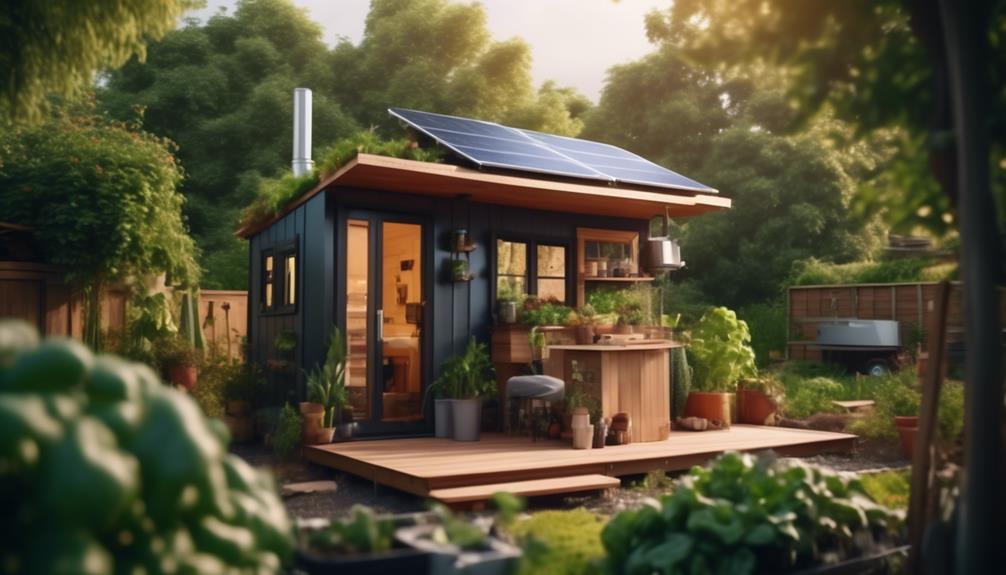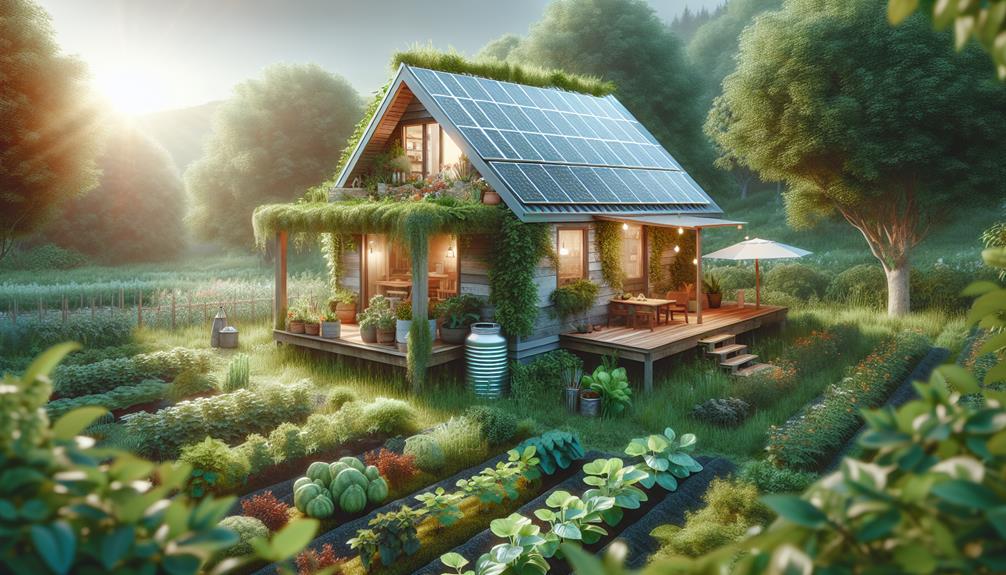Imagine your living space as a microcosm of the planet—what you put in, take out, and how you manage resources has a profound impact on your personal ecosystem. You've likely heard that tiny home living can help reduce your environmental footprint, but the path to a sustainable tiny abode isn't always clear-cut.
You're tasked with making smart choices about materials, energy use, and space efficiency to ensure your home is as green as it is cozy. From selecting recycled building materials to investing in solar panels, every decision you make can contribute to a healthier environment.
But beyond the obvious, there are countless nuances and hidden opportunities to enhance your eco-friendly lifestyle. As you consider how to shrink your space without compromising on sustainability, remember that the devil is often in the details.
With a few strategic moves, you can transform your compact living quarters into a beacon of environmental responsibility—let's explore how you can do just that, starting with the very foundation of your tiny home.
Key Takeaways
- Opt for sustainable materials in construction and furnishings, such as bamboo, reclaimed wood, and natural linoleum.
- Maximize space efficiency and organization with multifunctional furniture, built-in features, and vertical storage.
- Incorporate renewable energy sources like solar panels and wind turbines to reduce reliance on non-renewable energy and lower carbon footprint.
- Practice water conservation by installing low-flow fixtures, collecting rainwater, and implementing greywater systems.
Choosing Sustainable Materials
When selecting materials for your tiny home's flooring, opting for eco-friendly options like bamboo, sustainable wood, or natural linoleum can significantly lessen your environmental footprint. These sustainable materials aren't only kind to the planet during the construction process, but they're also durable and long-lasting, ensuring you won't have to replace them frequently.
Bamboo, for instance, is a rapidly renewable resource, making it an excellent choice for innovation-minded individuals like yourself. Moreover, consider using reclaimed or recycled materials. They bring unique character and history to your home while diverting waste from landfills.
Maximizing Space Efficiency
To maximize your tiny home's livable area, consider investing in multifunctional furniture that serves dual purposes while saving on space. By doing so, you're not only maximizing space efficiency but also contributing to a smaller carbon footprint, as you use less material and energy.
| Feature | Emotional Benefit |
|---|---|
| Multifunctional Furniture | Simplify life, reduce stress with uncluttered space |
| Vertical Storage | Elevate aesthetics, feel pride in smart organization |
| Collapsible Designs | Enjoy the freedom to transform spaces on demand |
Embrace built-in features and under-bed storage to keep your tiny home organized and free from clutter. Opt for foldable furniture that allows the flexibility to adapt your space for multiple uses. By prioritizing these innovative solutions, you'll live more sustainably, proving that less really is more.
Harnessing Renewable Energy

As you embrace tiny home living, integrating solar panels can significantly cut your reliance on non-renewable energy.
Consider the addition of a small-scale wind turbine if you're situated in a breezy locale; it's a potent complement to solar solutions.
Together, these technologies not only shrink your carbon footprint but also promise long-term savings on energy bills.
Solar Panel Integration
Harnessing the sun's power, solar panels offer tiny home dwellers a sustainable way to generate electricity and reduce their carbon footprint. By integrating solar panels, you're not just cutting costs; you're also joining the movement towards renewable energy and lower energy consumption. Solar power is your long-term ally, boasting low maintenance after the initial investment. And, for the space-conscious tiny home, solar roof panels are a seamless fit.
Here's a quick guide to why solar is the smart choice for you:
| Benefit | Description |
|---|---|
| Renewable | Solar power is inexhaustible, unlike fossil fuels. |
| Eco-friendly | Reduces reliance on polluting energy sources. |
| Cost-effective | Long-term savings on energy bills. |
| Low Maintenance | Minimal upkeep after installation. |
| Space-efficient | Solar roof panels complement tiny home design. |
Embrace innovation and make solar panels your tiny home's powerhouse.
Wind Turbines for Homes
While solar panels efficiently capture energy from the sun, wind turbines offer an alternative by converting the breeze into electricity for your tiny home. Here's how embracing wind power can innovate your living while cutting energy costs:
- Sustainable Power: Wind turbines harness the kinetic energy of the wind, providing a reliable source of renewable energy that complements your solar energy systems.
- Reduced Energy Costs: After the initial investment, the electricity generated significantly lowers long-term energy expenses.
- Green Lifestyle: By installing a wind turbine, you're contributing to a greener environment, reducing reliance on fossil fuels.
Incorporating wind turbines into your eco-conscious tiny home not only demonstrates your commitment to innovation but also ensures a self-sufficient, cost-effective lifestyle.
Embrace the wind as a powerful ally in your journey towards sustainability.
Minimizing Water Usage
To kickstart your tiny home's water conservation, consider installing low-flow fixtures and aerators. They'll significantly cut down your water usage without sacrificing performance.
You can also collect and utilize rainwater for your garden and toilet, reducing reliance on treated water.
Low-Flow Fixtures Installation
By installing low-flow fixtures and aerators in your tiny home, you'll significantly reduce water consumption and contribute to a more sustainable living environment. Embrace innovation with low-flow fixtures installation and witness the impact of less waste in your daily life.
Here's how you can optimize your water usage:
- Upgrade to Low-Flow Toilets: Save thousands of gallons per year by making the switch from traditional to low-flow or composting toilets.
- Install Faucet Aerators: These simple devices mix air with water, maintaining water pressure while using less water.
- Choose Efficient Showerheads: Opt for low-flow showerheads to cut down your water use without sacrificing comfort.
Change starts with your choices. Be a part of the solution by minimizing your footprint and promoting a greener future with every drop saved.
Rainwater Harvesting Systems
Continuing your journey toward sustainable living, consider implementing a rainwater harvesting system to further minimize your tiny home's water usage.
These systems are a cornerstone of an eco-friendly tiny home, allowing you to reduce your carbon footprint by tapping into a natural resource. By collecting rainwater, you're equipped for non-potable tasks like gardening and toilet flushing, significantly slashing your dependence on municipal supplies.
This isn't just eco-conscious; it's economical, promising savings on your water bill. With options to filter collected rainwater for laundry and bathing, you're not sacrificing comfort for conservation.
Embrace rainwater harvesting systems and you'll not only steward environmental resources wisely but also champion a lifestyle that's both innovative and responsible.
Reducing Waste and Consumption

Embracing a minimalist lifestyle can significantly reduce your waste footprint and streamline your consumption habits. Living in less space naturally encourages you to own fewer items, but it's about making each choice count.
Here's how you can live large with less:
- Choose Quality Over Quantity: Invest in durable goods that won't need frequent replacement. This means you'll consume fewer resources over time.
- Repurpose and Upcycle: Use reclaimed materials for your tiny home's construction and decor. This approach minimizes the demand for new resources and adds unique character to your space.
- Go Green with Energy: Opt for renewable energy sources like solar power to further decrease your ecological impact.
Incorporating Green Technology
While reducing waste is a solid start, integrating green technology can propel your tiny home's sustainability to new heights. Invest in solar panels to harness the sun's energy, a renewable resource that slashes your carbon footprint and energy bills. By choosing solar power, you're opting for eco-friendly and cost-effective living.
Select windows crafted from sustainable materials, enhancing insulation while trimming energy use. Insulate with sheep's wool or cotton, both recyclable, to maintain a cozy ambiance without overworking your heating or cooling system. Incorporate skylights to bask in natural light, reducing the need for artificial illumination and energy consumption.
Frequently Asked Questions
How Can I Make My Tiny House Sustainable?
You can make your tiny house sustainable by using green materials, implementing water conservation techniques, and installing a composting toilet to minimize waste and reduce your ecological footprint. It's smart, innovative living at its best!
What Are Some Environmental Technologies for Tiny Homes?
Your home can harness the sun like a plant with solar roofing, turn waste into resources with composting toilets, and collect nature's bounty using rainwater harvesting, propelling you toward a sustainable future.
Is a Tiny House Good for Sustainable Living?
Absolutely, a tiny house embodies sustainable living through minimalist design, resource conservation, and the perks of downsizing. You'll innovate your lifestyle, significantly reducing your ecological footprint while embracing a modern, eco-conscious approach.
How Can We Save Energy in a Tiny House?
You'd think a tiny house can't trim energy further, but it can! Install solar curtains, switch to LED lighting, and embrace composting toilets. You'll slash bills and champion sustainability in no time.
Conclusion
In conclusion, by embracing eco-friendly tiny home living, you're not just saving pennies, you're safeguarding planets. Your miniature abode, brimming with sustainable materials and green tech, isn't just a house—it's a revolution.
With every drop of water conserved and every watt of renewable energy harnessed, you become a titan of eco-efficiency. Lead the charge, shrink your footprint to a tiptoe, and let your tiny home be a colossal beacon of sustainability.

